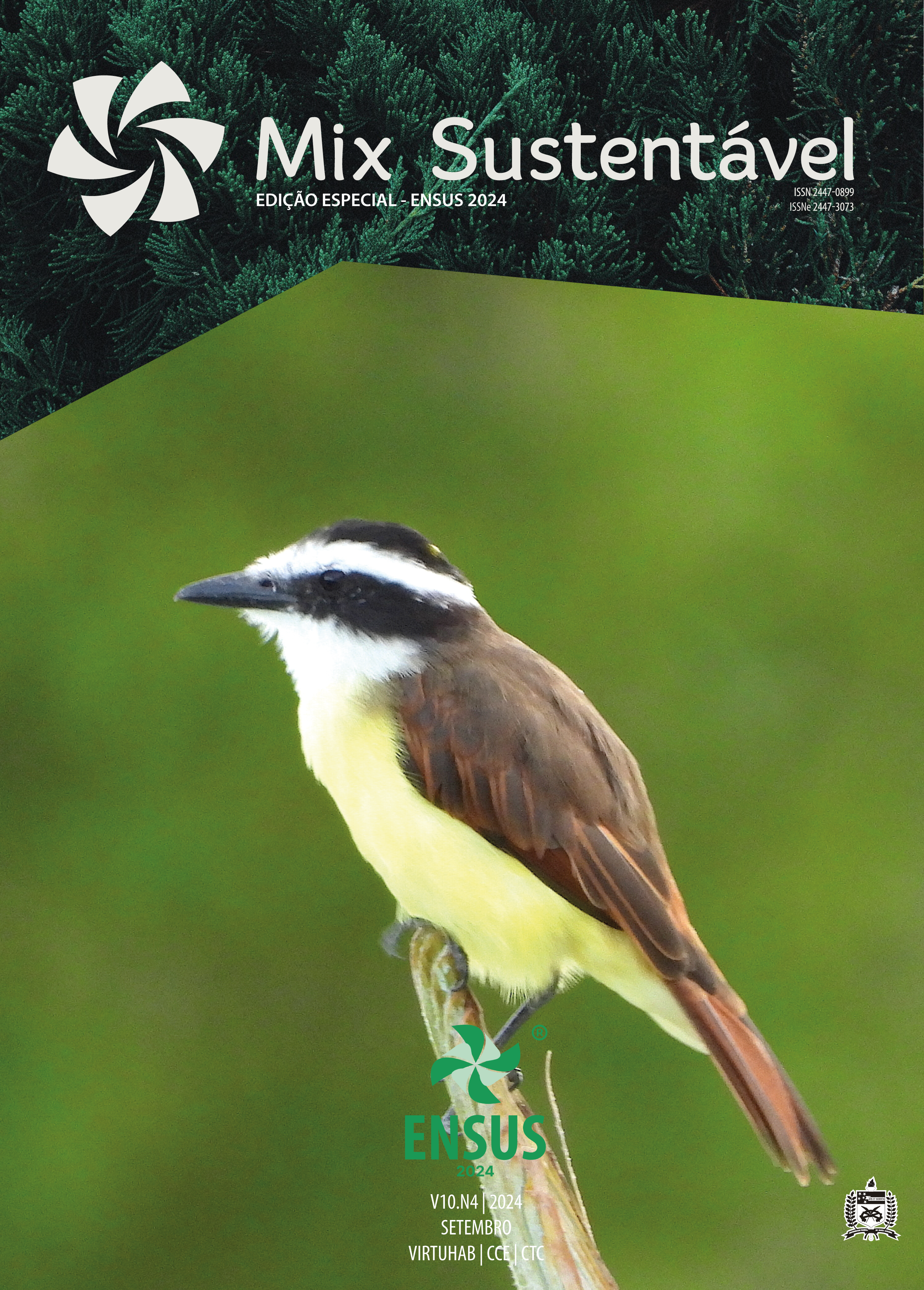THE HOUSING UNITS OF THE POSITIVE CLIMATE NEIGHBORHOOD PEDRA BRANCA SC/BR
A TYPOLOGICAL AND MORPHOLOGICAL ANALYSIS
DOI:
https://doi.org/10.29183/2447-3073.MIX2024.v10.n4.171-183Keywords:
typology of the building;, spatial arrangement;, sustinable neighborhood;, positive climate;, Pedra Branca NeighborhoodAbstract
In response to the global climate crisis, urgent measures are required to reduce greenhouse gas emissions in alignment with the goals of the Paris Agreement. As energy consumption accounts for 36% of total emissions, and buildings contribute significantly to both direct and indirect emissions, it is crucial to enhance the energy efficiency and self-sufficiency of buildings. This article conducts a case study to evaluate the formal structure, spatial layout, and sustainable strategies employed in residential units within the Pedra Branca neighborhood (Santa Catarina, Brazil), using the methodology developed by Brandão and Schneider. The findings indicate that the housing units predominantly consist of three bedrooms, along with two to four bathrooms. The analysis revealed partial integration between the kitchen and service areas, with full integration being less common. Corridor layouts were found to make the greatest contribution to sustainability and internal space quality. Although some configurations did not directly support cross-ventilation, there was a clear focus on environmental comfort and the use of passive design strategies. This study highlights the potential of such configurations to improve energy performance and contribute to the development of climate-positive neighborhoods.
References
MACEDO, Adilson Costa. A carta do novo urbanismo norte-americano. Revista Integração, n. 48, p. 11- 21, 2007.
TAHCHIEVA, Galina. Entrevista com Galina Tahchieva. Revista de Pesquisa em Arquitetura e Urbanismo, São Carlos: EESC-USP, n. 2, p. 108-110, 2005.
ANDRADE, G. M.; DOMENEGHINI, J.; MORANDO, J. P.; ROMANINI, A. Princípios do Novo Urbanismo no Desenvolvimento da Bairros Sustentáveis Brasileiros. Available from: https://www.researchgate.net/publication/284011657_Principios_do_Novo_Urbanismo_no_Desenvolvimento_de_Bairros_Sustentaveis_Brasileiros. Revista de Arquitetura da IMED, v. 2, n.1, 2013. Acesso em: 03/ 2023.
LOTTI, M. G. M. Processo de desenvolvimento e implansação de sistemas, medidas e práticas sustentáveis com vista a certificação ambiental de empreendimentos imobiliários – estudo de caso: Empreendimento Bairro Ilha Pura – Vila Dos Atletas 2016. Projeto de Graduação (Engenharia Civil) - Escola Politécnica, Universidade Federal do Rio de Janeiro, Rio De Janeiro, 2015.
YIN, R. K. Estudo de caso: planejamento e métodos. 3.ed. Porto Alegre: Bookman, 2005.
CIDADE PEDRA BRANCA. Um Pouco da História Pedra Branca - Cidade Criativa, 2024. Disponível em: http://cidadepedrabranca.com.br/um-pouco-de-historia/ Acesso: 04/2024.
RUMIS, Maximo; LEIVA, Marcela. Pedra Branca: o poder transformador do urbanismo. Nº 1 – Cidade Criativa Pedra Branca. Revista Área Arquitetura & Design da Região Sul. Ed. Ano 13, 06/2020.
PEDRA BRANCA EMPREENDIMENTOS IMOBILIÁRIOS S/A. Pedra Branca Cidade Criativa: melhorar a cidade para as pessoas. Palhoça: Pedra Branca - Cidade Criativa, 2014, 92 p.
Bohl, Charles C. Place Making: Developing Town Centers, Main Streets, and Urban Villages. ARCHITECTURE. Editor Urban Land Institute. Ebook. Publicação, Janeiro de 2002.
LUZ, A. P. F.; COLCHETE FILHO, A. F.; MAYA-MONTEIRO, P. M. Diretrizes para projetos sustentáveis em novas centralidades: breve revisão de conceitos. In: XII CONLAB. Lisboa: XII CONLAB, 2015.
MONEO, R. Rafael Moneo 1967-2004: antologia de urgencia. Madrid, El croquis editorial, 2004.
YOUNES, S. Quatremère de Quincy’s Historical Dictionary of Architecture: The true, the fictive and the real. Ed.: - 2000.
PEREIRA, R. B. Arquitetura, imitação e tipo em Quatremère de Quincy. São Paulo, tese de doutorado, FAUUSP, 2008.
MARTÍNEZ, A. C. Ensaio sobre projeto. Brasília, Ed. da Universidade de Brasília, 2000.
MONEO, Rafael. Origen del ensayo: De la Tipología. Artículo de la revista SUMMARIOS 79, Buenos Aires, julio, 1984, pp. 15-25. Publicado originalmente en inglés en OPPOSITIONS 13, New York, Invierno, 1978, pp. 22-45, 1978.
TRAMONTANO, M. Evolução recente da habitação contemporânea na cidade de São Paulo. Relatório Técnico. Programa CNPq/PIBIC. São Carlos: USP, 2000.
BRANDÃO, D. Q.; HEINECK, L. F. M. Apartamentos em oferta no Brasil: método de tipificação de plansas e análise de diversidade. In: III Simpósio Brasileiro de Gestão e Economia da Construção, 2003, São Carlos. Anais. São Carlos: UFSCar, 2003.
Brandão, Douglas. (2008). Tipificação e aspectos morfológicos de arranjos espaciais de apartamentos no âmbito da análise do produto imobiliário brasileiro. Ambiente Construído, Porto Alegre, v. 3, n. 1, p. 35-53, jan./mar. 2003. ISSN 1415-8876 © 2003, Associação Nacional de Tecnologia do Ambiente Construído.
SCHNEIDER, F. Atlas de Plansas: vivendas. 2. Ed: Barcelona: Editorial Gustavo Gili, 1998. 224 p.
IBGE. População estimada: IBGE, Diretoria de Pesquisas, Coordenação de População e Indicadores Sociais, Estimativas da população residente com data de referência 1o de julho de 2018. https://cidades.ibge.gov.br/. Acesso em 06/2023.
IMOVELWEB. Valor apartamento em Pedra Branca. 2018. Disponível em: Acesso em: 04/2023.
Censo 2022 do IBGE aponta: Palhoça tem 222.598 habitantes. Jornal Palhocense / Cotidiano. https://www.palhocense.com.br/noticias/censo-2022-do-ibge-aponta-palhoca-tem-222-598-habitantes. Publicado em 29/06/2023. Acesso: Março/2024.
United Nations Environment Programme, 2023. “Emissions Gap Report 2023: Broken Record – Temperatures hit new highs, yet world fails to cut emissions (again)”. Nairobi. https://doi.org/10.59117/20.500.11822/43922.
Canadell, J.G., P.M.S. Monteiro, M.H. Costa, L. Cotrim da Cunha, P.M. Cox, A.V. Eliseev, S. Henson, M. Ishii, S. Jaccard, C. Koven, A. Lohila, P.K. Patra, S. Piao, J. Rogelj, S. Syampungani, S. Zaehle, and K. Zickfeld, 2021. “Global Carbon and other Biogeochemical Cycles and Feedbacks”. In Climate Change 2021: The Physical Science Basis. Contribution of Working Group I to the Sixth Assessment Report of the Intergovernmental Panel on Climate Change. Cambridge University Press, Cambridge, United Kingdom and New York, NY, USA, pp. 673–816, doi: 10.1017/9781009157896.007
Downloads
Published
How to Cite
Issue
Section
License
Copyright (c) 2024 Natália Daniele de Lima Vinagre Fonseca

This work is licensed under a Creative Commons Attribution 4.0 International License.
Creative Commons Copyright Notice
Attribution 4.0 International




